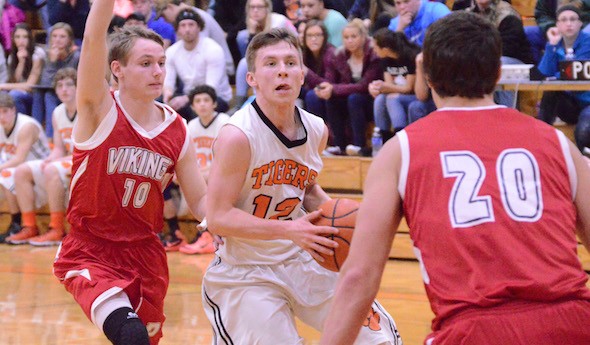
Hillman Becomes Basketball Town, Too
January 6, 2017
By Dennis Chase
Special for Second Half
HILLMAN – Eric Muszynski still remembers that day in 2005 when, as the newly appointed boys basketball coach at Hillman, he made a promise to the man who hired him, administrator Jack Richards.
 As they gazed at the banners in the school gymnasium – highlighted by the school’s three MHSAA Class D championships in baseball – Muszynski vowed to add some basketball banners to the collection.
As they gazed at the banners in the school gymnasium – highlighted by the school’s three MHSAA Class D championships in baseball – Muszynski vowed to add some basketball banners to the collection.
“He (Richards) chuckled,” Muszynski recalled. “He said, ‘Try to get to .500 first.’”
Historically, Hillman’s been a baseball town. The Tigers played for MHSAA championships four times in six years during the 1990s.
“Basketball was something you did to stay in shape for baseball,” said Richards, who went on to serve as superintendent for five years. “Eric’s turned that around.”
Since 2009, Hillman has won four North Star Conference basketball championships, five Districts and one Regional. The Tigers stretched their regular-season win streak to 44 after Thursday night’s 68-38 victory over Mio. Their last regular-season loss was to Cedarville in the 2014-15 opener.
Quite a turnaround for a program that had won only one league title prior to Muszynski’s arrival.
“And that wasn’t an outright title,” senior guard Gunnar Libby said.
Libby, a first-team Associated Press all-state pick last season, is the catalyst for this 5-0 Tigers team. A four-year varsity veteran, Libby has played a vital role in the program’s growth. Hillman won its first outright league title when he was a freshman, captured its first Regional crown when he was a sophomore, and posted its first unbeaten regular season when he was a junior.
“I’ve been really lucky to play on some good teams,” he said.
The turnaround did not happen overnight. The Tigers were 10-32 in Muszynski’s first two years.
“I remember thinking to myself, ‘Will we ever get over that hump?’” Muszynski wondered.
His boss stood by him.
“I had some people come to my office, saying he wasn’t the guy for the job,” Richards said. “I told them, ‘Settle down. This guy will bring us championships.’ Eric heard me, and he took it to heart. He worked hard to prove me right.”
In his third season, Muszynski led Hillman to an 11-10 mark. From there, the program took off.
“It’s been truly amazing,” the former Alpena High School standout said. “As a coach, you envision and hope that your program can do big things. We’ve been in that conversation – of trying to get down to East Lansing (for the Final Four) – since 2013 when we almost upset Cedarville (a double overtime loss) in the Regional Final.”
Hillman, sparked by Mason VanPamel and Ty Jones, reached the Quarterfinals in 2015 before losing to eventual champion Powers North Central.
It looked like the Tigers might be in for a rebuild last season, losing eight seniors and four starters to graduation. Instead, Hillman won its first 22 games before losing to Onaway 58-57 in the District Final.
“We were counted out from the very beginning,” Libby said. “We proved everybody wrong.”
Still, the setback to Onaway – a team Hillman had knocked out of the Districts the previous three years – left a bitter taste. Onaway reached the Quarterfinals, but that loss motivates the Tigers.
When his team first gathered for practice this season, Muszynski stressed the importance of “protecting” its league title as well as recapturing the District championship. Hillman had won three Districts in a row before its sudden exit last March.
“That District (trophy) should be in Hillman,” Libby said.
That statement reflects how far this program has evolved. It’s a program that’s now won 46 consecutive league games and 36 consecutive home games.
Those streaks continue to grow, although Libby admitted he’s lost count.
“You just go out there and do what you’ve got to do,” he said.
The 5-foot-9 Libby is the floor general and lone senior in the starting lineup. He averages 25 points and six assists per game. He surpassed 1,000 career points in the season opener when he dropped 30 on Cedarville.
“He’s lightning quick,” Muszynski said. “He’s a tough kid; a hard-nosed, old school style point guard.”
Libby’s backcourt mate, 5-10 junior Brandon Banks, averages nearly 15 a game.
“That’s been our recipe for success since 2009,” Muszynski said. “We usually feature two dynamic scorers.”
Andrew Funk, a 6-foot junior, is also averaging in double figures. He scored 19 in Tuesday’s win, hitting five of Hillman’s 13 3-pointers.
The Tigers compensate for lack of size with speed, a trapping defense and a dangerous perimeter game. Kory Henigan, a 6-4 sophomore, and Billy Kolcan, a 6-1 junior, are the tallest starters. Henigan averages eight points and seven rebounds while the athletic Kolcan, an MHSAA Finals qualifier in track and an honorable mention all-state player in football, spearheads the press.
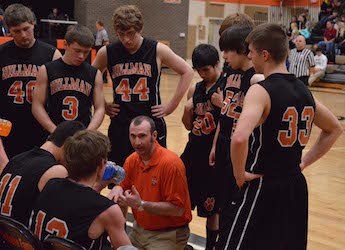 “He (Kolcan) plays up front on our press,” Muszynski said. “He makes us go. He’s one of the best athletes to come through our school in a long time.”
“He (Kolcan) plays up front on our press,” Muszynski said. “He makes us go. He’s one of the best athletes to come through our school in a long time.”
Kolcan, Banks and Funk were on varsity as sophomores last season.
“On paper, it appears we’re young,” Muszynski said. “But we’re battle-tested.”
And, according to Libby, cohesive, too.
“We work well together,” Libby said. “We’re unselfish – and we scrap.”
Now, the Tigers would like to start playing more basketball. Hillman played just three games in December after two contests were postponed due to weather.
“It’s hard to get any kind of rhythm and consistency when you play two games, then you’re off two weeks, you play one game, then you’re off another two weeks,” Libby said.
As for Muszynski, this is his 12th season at Hillman. He was hired as a physical education/health/social studies teacher and girls basketball coach. When the boys job opened soon afterward, he added that to his responsibilities. He coached both teams for two years before the MHSAA switched girls basketball season to the winter. Even though the girls were 30-12 in those two seasons under his leadership, he felt coaching boys basketball was his calling.
“I liked the challenge,” he said. “With the girls, I walked into a good program. With the boys, I wanted to see if I could build a program.”
With a win over Rudyard just before the holiday break, the 37-year-old Muszynski notched his 200th career win at Hillman (30 with the girls, 170 with the boys).
“He’s been a real blessing for us,” Libby said. “He’s a great coach. He holds us all accountable. He’s thorough, and he can motivate. He knows his stuff.”
“I’m truly blessed,” Muszynski added. “That’s (200 wins) a credit to my players, past and present.”
Muszynski echoed those same sentiments after he won the Associated Press Class D Coach of the Year honor last season.
“One of the proudest moments in my coaching career,” he admitted. “Not only was it a great reward, but it was a reflection of our basketball program here.”
Richards, meanwhile, takes satisfaction in the basketball program’s accomplishments. Now retired, he still follows the Tigers – and Muszynski.
What did he see in Muszynski when he hired him in 2005?
“He has a drive,” Richards said. “He knows what it takes and the work that’s involved. A lot of people just want to work during the season, and when it’s over they’re done. That’s not Eric. He’s a worker, a planner. You could see his desire.”
Richards also feared, once the boys started winning, that Muszynski might leave for a bigger school. He even mentioned that to Muszynski.
“Eric said, ‘You gave me the opportunity to be a head coach and I want to do right by you,’” Richards recalled. “I said, ‘I understand that. But let me give you a piece of advice: it’s easier to build a dynasty in a small town than in a large town.’ I think he’s done a pretty good job with that.”
Muszynski looked north to Cedarville for inspiration. Coach Dave Duncan developed that program into a state contender. The Trojans won an MHSAA title in 2007 and nearly another two years later.
“I thought if a small Class D school in the Upper Peninsula can do that, why can’t we?” Muszynski reasoned.
One of Muszynski’s first priorities was to start applying his philosophies in the youth program so by the time those players reached the varsity they would know the defensive schemes and offensive sets.
“They’ve seen success so they know the formula works,” Muszynski said. “If you have some success, and start to win championships, everyone starts to buy in.”
As for baseball? Practice is still several weeks away.
“When I first got there,” Richards recalled, “the kids, after basketball practice, would put their gloves on and throw the baseball around. They even had a batting cage in the old gym. Now, you don’t see a baseball glove in the gym during the winter.”
Now you see basketball banners.
 Dennis Chase worked 32 years as a sportswriter at the Traverse City Record-Eagle, including as sports editor from 2000-14. He can be reached at [email protected] with story ideas for Manistee, Wexford, Missaukee, Roscommon, Ogemaw, Iosco, Alcona, Oscoda, Crawford, Kalkaska, Grand Traverse, Benzie, Leelanau, Antrim, Otsego, Montmorency, Alpena, Presque Isle, Cheboygan, Charlevoix and Emmet counties.
Dennis Chase worked 32 years as a sportswriter at the Traverse City Record-Eagle, including as sports editor from 2000-14. He can be reached at [email protected] with story ideas for Manistee, Wexford, Missaukee, Roscommon, Ogemaw, Iosco, Alcona, Oscoda, Crawford, Kalkaska, Grand Traverse, Benzie, Leelanau, Antrim, Otsego, Montmorency, Alpena, Presque Isle, Cheboygan, Charlevoix and Emmet counties.
PHOTOS: (Top) Gunnar Libby, who has scored more than 1,000 points during his Hillman career, cuts through a group of defenders. (Middle) Hillman coach Eric Muszynski addresses his team. (Photos courtesy of The Alpena News.)
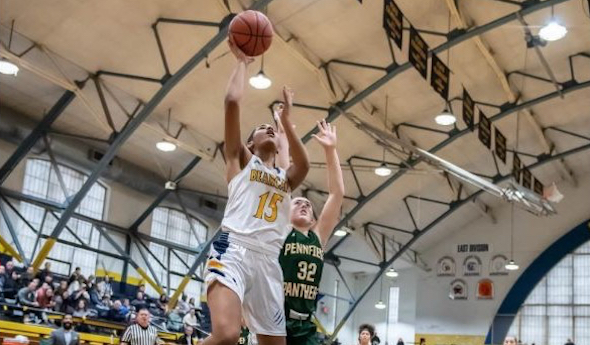
Hoops Finds Annual Home During Holidays
December 27, 2019
By Ron Pesch
Special for Second Half
Nothing says the Holidays like a high school basketball tournament.
It started, like many things do, with a drip. Well, make that a dribble.
The Michigan High School Athletic Association has allowed Holiday basketball tournaments for years. When was the first? That’s hard to establish. No one really kept track of such. A 1934 Wakefield News article indicates that a “Christmas Tournament will be held for the (Gogebic) Range teams at Wakefield December 27 and at Ironwood December 28.” Hurley, Bessemer, Ironwood and Wakefield were entered in the “blind” tournament, with opponents drawn just before game time. It was a new idea, at least in the Upper Peninsula.
“Nothing of its kind has ever been attempted in the Peninsula before,” stated the Ironwood Daily Globe. The tournament, won by Hurley, was a financial success. After expenditures, including the purchase of trophies, profit equaled enough that $22.42 was distributed to each school competing in the tournament. Plans were announced to bring back the tournament in a larger format the following year. It did return the following December, with the same teams in the same format but with all games played in Wakefield. This time out, Ironwood topped Hurley 22-21 for the tournament title.
In the Lower Peninsula in 1935, an All-Berrien County Holiday tournament was held Dec. 26, 27 and 28, with Three Oaks winning the Class B-C division title, 15-13 in the final over Berrien Springs. St. Joseph Catholic emerged as the Class D victor with a surprising 27-26 win over the reigning MHSAA state champ from Stevensville. The 14-team competition was played at Niles High School. Attendance was “slim, very slim” for the opening day of the tourney. The event did not return in 1936.
A similar, but much smaller, event was staged in Berrien County in 1941 with the Bridgman Class C Invitational. The tournament featured seven teams with contests spread over three nights. It was a success.
“Some 450 paid admissions were checked in Wednesday night for the championship finals, which Bridgman won from Berrien Springs. … The total paid admission for the three night event was 1,420 fans with a gross gate of approximately $400.”
By the mid-1940s, the idea of playing prep basketball during the Christmas lull had begun to take off across the state.
In December 1946, before a crowd of 1,500 at the Flint IMA Auditorium, Holland, the reigning Class A champion, downed Flint Northern 51-48 behind a pair of late field goals by Ken ‘Fuzz’ Bauman in the first annual Motor City Invitational. In Jackson, Detroit Catholic Central won the Michigan Catholic Invitational, beating Kalamazoo St. Augustine, 42-40. Bridgman again snagged the title at the Sixth Annual Berrien Class C Christmas Holiday Tournament. It was the Bees’ third Christmas championship in four years. The Little Eight Conference Holiday Tournament was played across four school gymnasiums as the calendar transitioned from 1946 to 1947. Bangor downed Covert, 34-29, in the championship contest hosted at Watervliet High School on Saturday, Jan. 4.
“Holiday tournament basketball has really caught on in Michigan,” said Hal Schram in the Detroit Free Press in 1947. “There will be no Christmas-New Year’s rest for at least 60 Michigan high school squads which have jumped at the chance to sharpen their collective shooting eyes for the long season ahead. … At last count, tournaments will be played between Dec 17 and Jan 3 at Flint, Saginaw, Grand Rapids, Jackson, Lincoln Park, Fremont, Negaunee, Marquette, Benton Harbor and Detroit.”
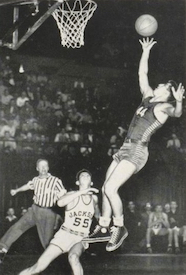 The same eight schools that played at the first Motor City tournament – Jackson, Grand Rapids Central, Holland, Muskegon Heights, Monroe, Midland, Flint Central and Flint Northern – were invited back for the second year. According to Schram, “Not a single participating school of a year ago wanted to be left out.”
The same eight schools that played at the first Motor City tournament – Jackson, Grand Rapids Central, Holland, Muskegon Heights, Monroe, Midland, Flint Central and Flint Northern – were invited back for the second year. According to Schram, “Not a single participating school of a year ago wanted to be left out.”
Jackson downed Flint Northern in the title game, 39-34.
The Saginaw Invitational, hosted at Arthur Hill High School, boasted six Class A schools as well as Alma and Mount Pleasant, both Class B schools. Mount Pleasant surprised the field, winning the tournament with a 40-25 triumph over Dearborn Fordson in the championship game.
A year later in December, Schram wrote, “The Michigan High School Athletic Association wasn’t caught unaware when the tournament bug started to bite every sector of the state.”
“Never did we expect such a wave of tournament play as we will see during the next three weeks,” said Charles Forsythe, state director for the MHSAA, noting 34 Christmas vacation tournaments were scheduled between December 15 and January 8 during the 1948-49 basketball season. “Perhaps we’re lucky at that. The Oklahoma association has had to sanction 123 tournaments.”
Forsythe and Schram explained the reasons for the wave of popularity. Of particular interest was the fact that, at the time, a school sponsoring both football and basketball could play a total of no more than 24 games, combined, in the two sports. However, MHSAA rules allowed a basketball team the chance to play as many as three games during a Holiday tournament and be charged with only one of its allotted combination of 24 contests. (The MHSAA rules changed prior to 1972-73 to allow basketball teams a maximum of 20 games.)
Coaches could keep their squads sharp during the two-week layoff with games rather than just mandatory practices. And, as a bonus to all because tournaments were financed through gate admissions, invitations to larger tournaments meant teams got to “stay and eat at the best hostelries, go on sightseeing tours when not playing and play non-conference opponents from other sections of the state.“
Add in the chance to play before larger-than-normal crowds, and the formula for a successful tournament was cast.
Beginning with the 1950-51 season, the football-basketball rule was altered to count play in mid-season invitational tournaments as two contests. With the change, according to the Detroit Times, “the number of such meets dropped sharply.”
Only nine Holiday tournaments, involving 50-plus teams, were recorded by the MHSAA during the 1951-52 season: the 5th annual Flint Parochial Invitational, the Alpena Catholic Invitational (involving 16 teams), the 5th Annual Greater Lansing Invitational, the Albion College Invitational, the Twin-Five Conference Christmas Tournament (a 10-team replacement for the disbanded Little Eight Conference’s tournament), the Otisville Invitational, the Columbiaville Invitational and the 1st Annual Portland St. Patrick Christmas Invitational.
But by the 1960s, Holiday Tournaments were again regaining popularity, with more now focused on teams from a specific community or section of the state, especially among smaller schools.
The St. Patrick tournament was still going strong in 1966 – its 15th year – with an eight-team, four-day design. Williamston downed a Cinderella squad from Carson City, 64-44, before 1,100 fans at Portland to earn the championship. Other Mid-Michigan holiday tournaments played out in Chelsea and Swartz Creek at the same time.
The Flint Parochial League Tournament was a mainstay of the Holiday season until the breakup of the league in the early 1970s.
“Basketball tournaments have become popular around the state and nation in recent years,” wrote Wendy Foltz, longtime Battle Creek Enquirer sports editor, before the kickoff of the inaugural Battle Creek Central Holiday Cage Tournament in 1968. In a twist that harkened back to earlier days, the eight-team event represented nearly every section of lower Michigan. “Battle Creek never has been a rabid basketball town like some around the state,” added a hesitant Foltz, noting a hope that the event could at least break even.
Hosted at the Cereal City’s historic Fieldhouse, built in 1928, that first tournament was won by host Battle Creek Central, which downed Traverse City 71-53 before a crowd of 2,000. Phil Todd led the Bearcats with 29 points, including 21 in the first half, while 6-foot-8 Tom Kozelko paced TC with 24. Muskegon Heights won the consolation game, holding off a late Ypsilanti Willow Run rally, 78-77. Other schools competing were Battle Creek Lakeview, Grand Blanc, Romulus and recently-opened Jackson Lumen Christi.
Chuck Turner, Central’s head coach, and junior varsity coach Jack Schils had contacted 60 schools during the summer of 1967 to organize the 12-game schedule.
“The response was terrific,” said Schils, who added, “Many schools could not accept because of schedule commitments but want to enter a year hence.”
The Battle Creek tournament was back in 1969, again hosting teams from near and far. Schils noted that cost ran high when teams were brought in from long distances: “However, this type of tournament is highly desirable so we hope fans will support it.”
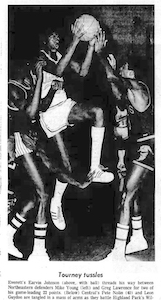
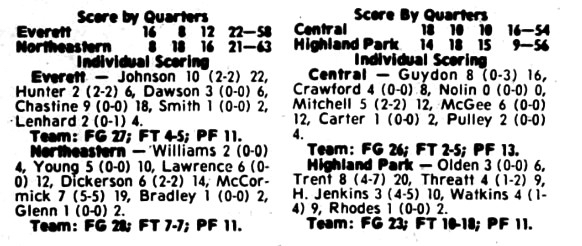 But the event was discontinued following the 1970-71 season when the “eight team format became too unwieldy,” according to the Enquirer “… and both crowd and the quality of play declined.”
But the event was discontinued following the 1970-71 season when the “eight team format became too unwieldy,” according to the Enquirer “… and both crowd and the quality of play declined.”
Pared down to a four-team format, it returned in a big way in December 1975. The tournament saw standing-room-only crowds of more than 3,000 for games between Battle Creek Central, Detroit Northeastern, Class A quarterfinalist Lansing Everett and reigning Class A champion Highland Park.
Detroit Northeastern downed Lansing Everett, 63-58 for the Cereal City championship trophy. Everett junior Earvin Johnson scored 22 points and, with teammate Reggie Chastine, was named to the all-tournament team along with Northwestern’s Wilbert McCormick, the tourney MVP, and his teammate Greg Lawrence. Highland Park’s William Trent and Battle Creek Central’s Leon Guydon also were named to the team.
By the 1980s, it seemed that the Christmas break nearly mimicked March in Michigan.
“I think a Christmas tournament really helps your program,” said Turner in 1980 to the Enquirer. He had taken over the head coaching position at Battle Creek in the fall of 1967 after a successful stint at Willow Run. “I don’t understand basketball teams having a preseason, playing three or four games, then taking two weeks off. When you get back, it’s like starting over.”
Besides Turner’s squad, the 1980 field included Detroit Western, Detroit Murray Wright and eventual winner Kalamazoo Central. The event would ultimately be re-christened the Battle Creek Central Chuck Turner Holiday Classic.
“The late Chuck Turner started bringing big games to the city over the holidays when he first started at the school in the 1960s,” wrote Bill Broderick in the Enquirer in 2018.
“Chuck started this because he wanted to give people the chance to come back home for the holidays and see everyone play. It’s been like a family reunion over the years,” Fred Jones told Broderick. Jones was a longtime assistant to Turner. “That we can keep it going in his name is great and hopefully we can keep if going for another 50 years.”
The girls are now part of the action. All five Battle Creek city schools – Central, Pennfield, Harper Creek, Lakeview, and St. Philip – were part of the event in 2018.
This year the Chuck Turner Central Field House Holiday Classic will again span two days – December 27 and 28 – and will again see all five city schools play on the historic floor.
Other Holiday tournaments scheduled this year include:
Petoskey Invitational – December 13-14
Raider Shootout – December 21
18th Annual Muskegon Area Sports Hall of Fame Classic – December 27
Earl McKee Classic – December 27-28
North Farmington Holiday Extravaganza – December 27
Motor City Roundball Classic – December 27
Cornerstone Invitational – December 27
Washtenaw Hoops Showcase – December 28
 Ron Pesch has taken an active role in researching the history of MHSAA events since 1985 and began writing for MHSAA Finals programs in 1986, adding additional features and "flashbacks" in 1992. He inherited the title of MHSAA historian from the late Dick Kishpaugh following the 1993-94 school year, and resides in Muskegon. Contact him at [email protected] with ideas for historical articles.
Ron Pesch has taken an active role in researching the history of MHSAA events since 1985 and began writing for MHSAA Finals programs in 1986, adding additional features and "flashbacks" in 1992. He inherited the title of MHSAA historian from the late Dick Kishpaugh following the 1993-94 school year, and resides in Muskegon. Contact him at [email protected] with ideas for historical articles.
PHOTOS: (Top) The Battle Creek Central and Pennfield girls face off during the 50th Chuck Turner Classic. (Middle) Shaheen Shaheen scores two points for Flint Northern, which fell to Jackson 39-34 during the 1947 Motor City championship game. (Below left) Lansing Everett’s Earvin Johnson makes a move toward the basket against Detroit Northeastern during the 1975 Battle Creek event. (Below right) Box scores from the 1975 tournament include Johnson’s 22 points in the 63-58 loss. Photos courtesy of the Battle Creek Enquirer, Lansing State Journal and Ron Pesch archives.)

